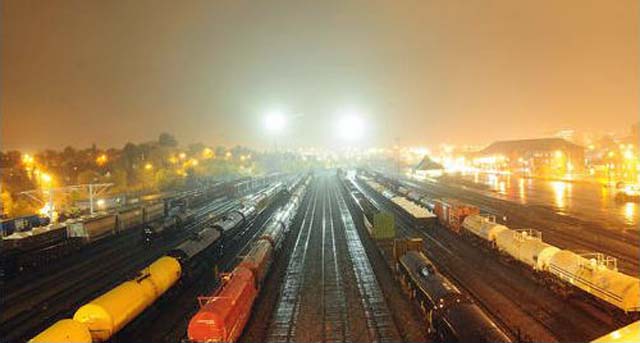
2011
|


Rain is reflected off the tracks at Sudbury's downtown rail yard.
14 October 2011
Rail Yard Could Cost $468M
Sudbury Ontario - It would cost from $235 million to $468 million to move the CP Rail tracks out of downtown and reclaim land many
argue is one of the most valuable assets Greater Sudbury has, a new study reveals.
The draft study, prepared under the guidance of economist David Robinson, of the Institute of Northern Ontario Research and Development, was written on behalf
of Imagine Sudbury, an interest group founded three years ago to lobby for the reclamation of the 52-acre rail corridor and shunting yard on downtown's
doorstep.
"For railroads, old yards in populated areas are a questionable asset," Robinson writes.
"They cannot be expanded to handle higher volumes and especially longer trains, there are liability issues and operating speeds are low. A modern yard
north of the city provides economic gains for both CP and CN." Specifically, the study determined the cost of creating a new rail yard, likely north of
the old city somewhere between Garson and Azilda. The closer the new yard is to Azilda and Vale's properties, the greater the economic benefit, the report says.
The cost estimates include connections to all existing lines as they enter the city, junctions, overpasses for Regional Road 80, and Highway 17 East.
The cost estimates represent the likely range for a "no-frills" project depending on options chosen, Robinson said. The estimates are intended to
pave the way for a pre-feasibility study and serve as a baseline against which public and private benefits should be compared.
These benefits, Robinson notes, are significant, even for the rail companies.
Specifically, saving as much as 30 minutes for 10 CP freight trains per day through Sudbury is equivalent to five hours of increased use per day of a
transcontinental train.
The saving on motive power alone could be worth approximately $2 million per year for CP.
As well, "improved passing and bi-directionality should prevent delays. The time saving may assist in reducing the number of crew changes required for
transcontinental freight."
The study did not take into consideration the cost of reclaiming the downtown rail lands, although this is not expected to be prohibitive.
"We suggest the lands given up, net of environmental liabilities, have a positive value," Robinson said. "Further, the positive value
approximates the value of the lands that CP would receive in exchange."
Imagine Sudbury has previously determined the value of the reclaimed land for commercial and high-residential use would be about $500 million, which Robinson
has always assumed would be more than enough to pay the railway relocation costs, an assumption his study confirms.
Imagine Sudbury maintains the railway tracks are an impediment to economic, social, and cultural development in the city core. Removal of the downtown rail
yards in Sudbury has been on the policy agenda for 50 years.
"Other cities have done it, and other cities are currently doing it," Robinson said. "As cities develop, downtown land simply becomes too
valuable to use for sorting freight."
The study comes at a crossroads for downtown. A year-long master plan promises to deliver a range of dramatic project options designed to reshape downtown in
the coming decades. Though it's unlikely reclaiming the railway tracks will be a priority, it is already being considered a possibility.
In approving in principle a plan to sell Market Square to Laurentian University as the future home of the Northern Ontario School of Architecture, one of the
conditions was a right-of-way across the property to extend Larch Street across the tracks an link up with Lorne Street.
Over the past two years, members of Imagine Sudbury have met with the Northern Ontario Heritage Fund Corp., FedNor, Bombardier Inc., CP Rail, and Vale, about
the proposal.
None of these necessary partners have shut the door to the project, Robinson has previously told The Star.
Relocating the Tracks Would:
Improve interlinkages between CP and CN transcontinental lines;
Provide an improved yard accessible to both rail companies;
Cut freight transit time for CP through Sudbury by 20 to 50 minutes;
Reduce level crossings for CP;
Retain links with the Ottawa Valley line and the Huron Central line;
Improve connections with Vale trackage;
Provide an opportunity to expand the supply of rail-adjacent industrial land for Sudbury.
Mike Whitehouse.

|

